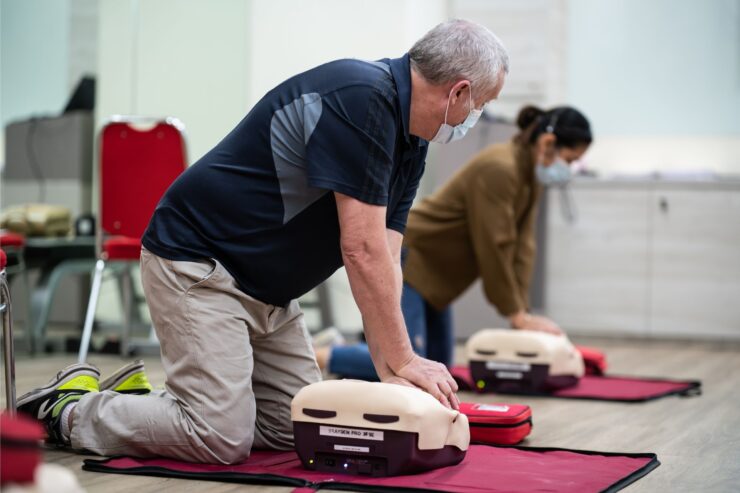We’ve all seen movies when someone collapses, or there is an accident, and one person asks if anyone there is a doctor or if anyone knows first aid. Those things don’t happen only in movies, and since there are hundreds of thousands of accidents happening every day all around the world, we need to stay prepared and vigilant. In this article, we are going to teach you how to transfer from being a bystander to becoming a rescuer. Keep on reading to know why learning CPR with first aid training is a must if you want to be able to react properly in every given scenario.
What is the role of CPR in saving lives?
Cardiac resuscitation, commonly referred to as CPR, is an essential emergency procedure for victims of sudden cardiac arrest. It isn’t just about reviving someone; it’s about maintaining an adequate oxygen supply to the brain and vital organs, ensuring minimal damage during the critical period before medical help arrives. Initiating the kiss of life procedure within the first few minutes can significantly increase the chances of survival. Every second counts in these situations, and timely intervention can spell the difference between life and death.
Why is it vital to get certified?

While the fundamentals of mouth-to-mouth resuscitation might seem straightforward, the approach needs precision, confidence, and technique. Acquiring certification in this life-saving procedure is an invaluable step in this journey. Such programs not only provide hands-on training but also equip you with the theoretical knowledge behind each action, ensuring your interventions are both safe and effective. Moreover, becoming certified adds credibility to your skills, allowing others to trust in your capability during high-stress scenarios. If you want to start this journey and get certified in first aid and CPR then you should visit https://cprcertificationnow.com/products/cpr-first-aid-certification.
You can always use modern technology to practice
Today, technology has permeated nearly every facet of our lives, and cardiopulmonary resuscitation training is no exception. Many institutions employ high-fidelity manikins that simulate real-life scenarios. These advanced dummies provide real-time feedback, ensuring that your compression depth, rate, and rescue breaths are up to the mark. By practicing on these technologically advanced systems, you’re not just memorizing the procedure but genuinely understanding the nuances that could make a life-changing difference.
What are the layers of this procedure?

One of the key components of cardiopulmonary resuscitation is the kiss of life – a method that involves delivering rescue breaths to the victim. This is a meticulous procedure requiring careful attention to detail. It isn’t just about breathing air into the victim’s mouth; it involves ensuring the airways are clear, providing the right amount of air, and doing so at the right intervals. Such intricacies emphasize the necessity of proper training and understanding before attempting this on someone.
How do you adapt to different scenarios?
This procedure isn’t a one-size-fits-all. From infants to elderly individuals, the approach varies. For instance, while deep chest compressions might be necessary for adults, children, and especially infants require gentler and more careful handling. Additionally, certain situations, like drowning incidents or trauma-induced unconsciousness, necessitate specific preliminary actions before initiating cardiopulmonary resuscitation. Comprehensive training equips you to handle a plethora of emergencies with dexterity and adaptability.
How to prepare for things you don’t even expect?

There might be situations where the standard CPR procedure needs to be tweaked. For instance, pregnant women or individuals with certain medical implants might require a modified approach. Gaining knowledge about these special circumstances ensures you’re equipped to handle a wider range of emergencies. It’s about being prepared for the many curveballs life might throw at you.
Know that you need to practice to master this technique
Mere theoretical knowledge of cardiac resuscitation isn’t enough. Like any physical skill, this method requires consistent practice to perfect. Repeatedly engaging in mock drills helps in cementing the sequence of actions into your muscle memory. This ensures that in real-life emergencies, your body instinctively knows what to do, even if your mind is grappling with the stress and urgency of the situation.
When you learn as part of a group, you can become better
One of the most underrated yet highly beneficial methods of learning the kiss of life procedure and other techniques is group learning. When you’re in a room with fellow aspirants, you get the opportunity to observe, critique, and learn from a diverse set of individuals. Every person brings their unique perspective and set of experiences, making it a rich learning ground where mistakes are rectified, myths are debunked, and best practices are reinforced.
Know that this field is always evolving

The field of emergency medical care is continuously evolving. New research and studies often lead to changes in best practices. As someone committed to saving lives, it’s crucial to stay updated. This might mean refresher courses, attending workshops, or simply engaging with the latest literature on the subject. Being proactive about your knowledge ensures that you’re always prepared with the most recent and effective methods.
Understand the ethical aspects of this procedure
While the primary focus of this procedure is to save lives, there’s also an ethical dimension to it. Consent, especially when administering the kiss of life procedure, becomes crucial. In many situations, the victim isn’t in a position to provide or deny consent. Understanding the ethical guidelines and the legal protections available to you as a good samaritan can ensure that you act with confidence and integrity.
How do you navigate the post-event trauma?
Being a part of such intense, high-stakes situations can leave emotional scars. Whether you successfully resuscitate someone or face the tragic outcome of loss, the emotional aftermath can be overwhelming. Recognizing and addressing this trauma is as crucial as the physical act of performing CPR. Seek counseling, join support groups, or simply share your feelings with trusted individuals to navigate through these emotional mazes.
In the vast arena of life skills one can acquire, knowing cardiopulmonary resuscitation stands out as an exceptionally noble one. It’s not just about mastering a technique; it’s about holding the power to gift someone a second shot at life. As you journey from being a bystander to a rescuer, remember that with great power comes great responsibility – and there’s no greater responsibility than safeguarding a life.

